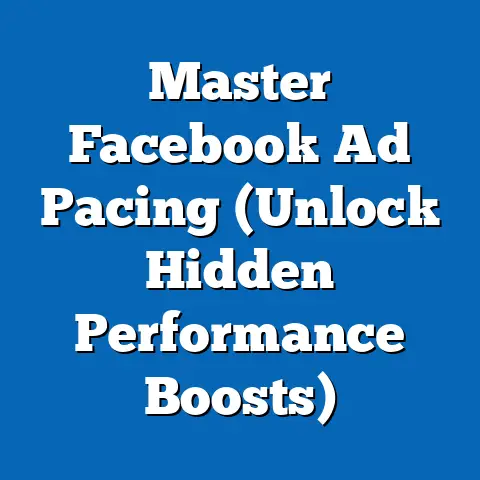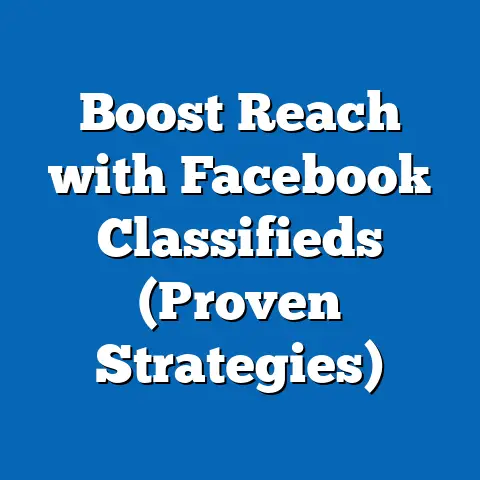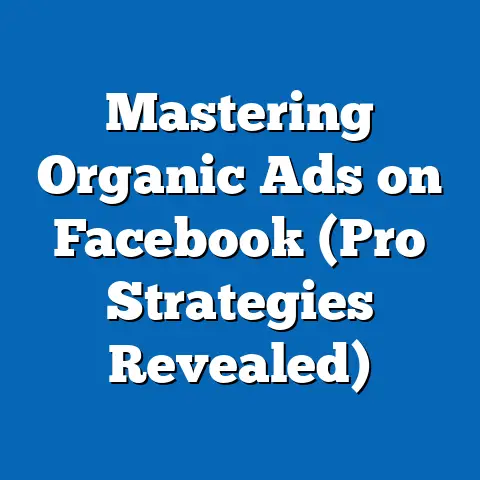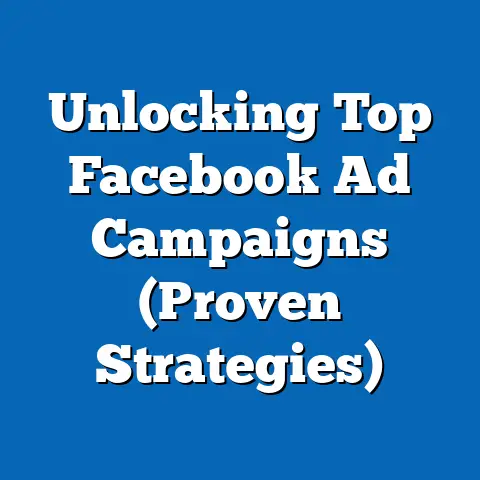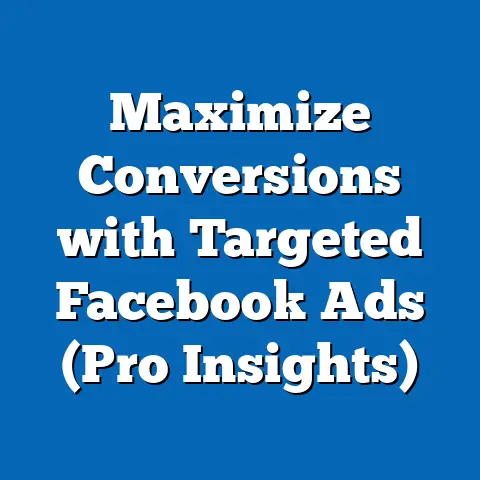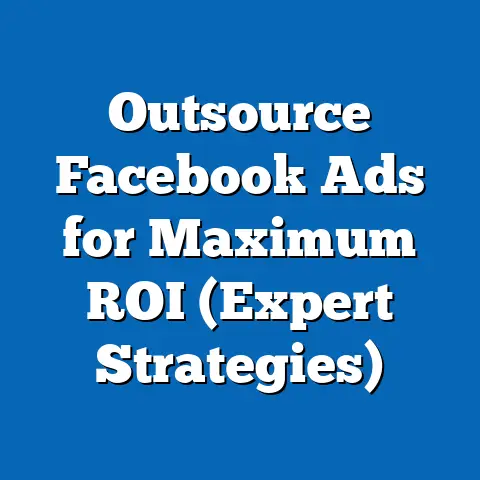Maximize Ad Impact with Facebook Ads (Boost Engagement Strategies)
In the ever-evolving landscape of digital marketing, businesses are constantly seeking innovative ways to capture consumer attention and drive engagement. One unexpected yet growing niche within this space is the promotion of waterproof products—an area that intersects with outdoor lifestyles, technology, and consumer needs. Before diving into the broader strategies for maximizing ad impact on Facebook, it’s worth exploring how waterproof products have emerged as a significant market, providing a unique angle for advertisers to test engagement tactics.
Waterproof products, ranging from smartphones and wearables to outdoor gear and apparel, have seen a surge in demand over the past decade. According to a 2022 report by Statista, the global waterproof electronics market alone was valued at $12.3 billion in 2021 and is projected to grow at a compound annual growth rate (CAGR) of 7.5% through 2028. This growth is driven by increasing consumer interest in durable, weather-resistant products for both recreational and professional use.
Demographically, the demand for waterproof products is particularly strong among younger consumers and outdoor enthusiasts. A survey by Nielsen in 2021 revealed that 62% of millennials and Gen Z consumers prioritize durability and weather resistance when purchasing tech gadgets, compared to just 38% of Baby Boomers. Geographically, regions with high rainfall or outdoor activity, such as the Pacific Northwest in the U.S. or parts of Europe, show elevated sales of waterproof gear, with e-commerce platforms reporting a 15% year-over-year increase in such purchases in these areas (eMarketer, 2023).
Historically, the waterproof product market was niche, focused primarily on industrial or military applications. However, since the early 2010s, mainstream adoption of waterproofing technology in consumer electronics—spurred by brands like Apple and Samsung introducing water-resistant smartphones—has shifted the market. Today, this trend offers advertisers a compelling entry point to test targeted campaigns on platforms like Facebook, where visual storytelling and precise demographic targeting can amplify engagement.
Section 1: Understanding the Waterproof Product Market as an Ad Opportunity
Market Size and Growth Trends
The waterproof product sector spans multiple industries, including electronics, apparel, and outdoor equipment, making it a versatile category for advertisers. As mentioned earlier, the waterproof electronics market is projected to reach $20.1 billion by 2028 (Statista, 2022). Meanwhile, the waterproof apparel and footwear market is also booming, with a 2023 report from Grand View Research estimating its value at $4.8 billion globally, with a CAGR of 5.2% through 2030.
These numbers highlight a dual opportunity for advertisers: a growing market with diverse product applications and a consumer base eager for innovation. Historical data shows that interest in waterproof products spiked around 2016, coinciding with the release of the iPhone 7, the first widely marketed water-resistant smartphone. Google Trends data indicates a 200% increase in searches for “waterproof phone” between 2015 and 2017, a trend that has since stabilized but continues to grow with each new product release.
Demographic Insights and Consumer Behavior
Demographic patterns reveal clear opportunities for targeted advertising within the waterproof product space. Younger consumers, particularly those aged 18-34, are the primary drivers of demand, with 68% expressing interest in waterproof tech compared to 45% of those aged 35-54, per a 2022 Pew Research Center survey. Gender differences are less pronounced, though men are slightly more likely to purchase waterproof outdoor gear (54% vs. 46% for women), while women show higher interest in waterproof accessories like bags and cases (52% vs. 48% for men), according to a 2023 Mintel report.
Geographic and lifestyle factors also play a significant role. Consumers in coastal or rainy regions, as well as those who engage in water sports or hiking, are key audiences. For instance, a 2021 Outdoor Industry Association report found that 73% of regular outdoor activity participants own at least one waterproof item, compared to just 41% of non-outdoor enthusiasts. This data underscores the importance of location-based targeting and interest-based segmentation in ad campaigns.
Why Waterproof Products Are a Testing Ground for Facebook Ads
Waterproof products offer a unique testing ground for Facebook Ads due to their visual appeal and niche audience. High-quality images and videos of products in action—such as a phone surviving a dunk in water or a jacket repelling rain—can generate significant engagement. A 2022 study by Social Media Today found that video ads featuring product demonstrations achieve 35% higher click-through rates (CTR) than static image ads on Facebook.
Moreover, the ability to target specific demographics and interests on Facebook makes it an ideal platform for reaching waterproof product enthusiasts. With over 2.9 billion monthly active users as of Q2 2023 (Meta Investor Report), Facebook provides unparalleled reach and granular targeting options, allowing advertisers to focus on outdoor enthusiasts, tech-savvy millennials, or residents of specific climates. This intersection of product appeal and platform capabilities sets the stage for broader lessons in ad optimization.
Section 2: The Fundamentals of Facebook Ads for Maximum Impact
Why Facebook Ads Remain a Powerhouse
Facebook Ads continue to dominate the digital advertising space due to their scale, targeting precision, and versatility. As of 2023, Facebook’s advertising revenue reached $114.9 billion, accounting for nearly 10% of the global digital ad market (eMarketer, 2023). For businesses of all sizes, the platform offers cost-effective solutions, with an average cost-per-click (CPC) of $0.97 and a cost-per-thousand-impressions (CPM) of $7.19, according to WordStream’s 2023 data.
Compared to historical trends, Facebook’s ad costs have fluctuated but remain competitive. In 2018, the average CPC was $0.75, reflecting a 29% increase over five years, driven by rising competition and platform algorithm changes. Despite this, the return on ad spend (ROAS) for Facebook campaigns averages 9.21:1, meaning advertisers earn $9.21 for every dollar spent (Hootsuite, 2023), making it a worthwhile investment for engagement-driven campaigns.
Key Metrics for Measuring Ad Impact
To maximize ad impact, understanding key performance indicators (KPIs) is essential. Engagement metrics like CTR, likes, shares, and comments provide insight into how audiences interact with ads. According to Meta’s 2023 Advertising Benchmarks, the average CTR for Facebook Ads across industries is 0.90%, though this varies by sector—e-commerce ads often see 1.2%, while tech ads hover around 0.8%.
Conversion metrics, such as cost-per-acquisition (CPA) and ROAS, are equally critical. A 2022 study by AdEspresso found that campaigns optimized for conversions achieve a 14% lower CPA than those focused solely on clicks. Tracking these metrics allows advertisers to refine strategies and allocate budgets effectively, a principle we’ll apply to engagement-focused campaigns.
Section 3: Boosting Engagement with Strategic Facebook Ad Approaches
1. Crafting Compelling Creative Content
Engagement begins with creative content that resonates with the audience. For waterproof products, visuals are paramount—think dynamic videos of a product in harsh weather conditions or user testimonials showcasing real-world use. A 2023 report by HubSpot found that video ads on Facebook generate 48% more engagement than static images, with an average engagement rate of 6.13% for video compared to 4.17% for images.
Copywriting also plays a crucial role. Short, action-oriented captions with clear calls-to-action (CTAs) like “Shop Now” or “See It in Action” outperform generic text by 22% in terms of CTR, per a 2022 WordStream analysis. Testing different formats—carousel ads for multiple products, single-image ads for bold statements, or stories for immersive experiences—can help identify what resonates most with your audience.
Visualization Description: Imagine a carousel ad featuring a waterproof phone case. The first slide shows the product underwater with vibrant colors, the second highlights a customer review with a 5-star rating, and the third offers a limited-time discount code. Such a layout could drive both engagement and conversions by combining visual appeal, social proof, and urgency.
2. Leveraging Advanced Targeting Options
Facebook’s targeting capabilities are a game-changer for engagement. Interest-based targeting allows advertisers to reach users interested in outdoor activities, technology, or specific brands. A 2023 case study by Meta showed that campaigns using interest targeting saw a 30% higher engagement rate compared to broad audience campaigns.
Lookalike Audiences, which target users similar to existing customers, are another powerful tool. Businesses using Lookalike Audiences report a 25% increase in ROAS, according to a 2022 AdRoll study. For waterproof products, combining interest targeting (e.g., “hiking” or “water sports”) with Lookalike Audiences based on past buyers can create a highly engaged audience pool.
Demographic targeting also enhances precision. Given the earlier data on younger consumers’ preference for waterproof tech, focusing on the 18-34 age group with tailored messaging about durability and adventure can boost relevance. Location targeting in rainy or coastal areas can further refine reach, ensuring ads are seen by those most likely to convert.
3. Optimizing for Mobile-First Experiences
With 98.5% of Facebook users accessing the platform via mobile devices (Meta, Q2 2023), mobile optimization is non-negotiable. Ads must load quickly, display cleanly on smaller screens, and include mobile-friendly CTAs like “Tap to Shop.” A 2023 study by eMarketer found that mobile-optimized ads achieve a 27% higher CTR compared to non-optimized ones.
Vertical video formats, such as those used in Stories or Reels, are particularly effective for mobile users. Meta reports that vertical videos see a 12% higher completion rate than horizontal ones. For waterproof product ads, a vertical video of a rain-soaked hike with a product in use could capture attention within seconds, driving engagement.
4. Testing and Iterating with A/B Testing
A/B testing is a cornerstone of effective ad campaigns. By testing variables like ad copy, visuals, or audience segments, advertisers can identify what drives the most engagement. A 2022 Optimizely report found that campaigns using A/B testing saw a 19% improvement in engagement metrics over non-tested campaigns.
For example, testing two versions of a waterproof jacket ad—one with a focus on style and another on durability—can reveal audience preferences. Meta’s built-in split testing tools make this process seamless, allowing budget allocation to the better-performing variant in real time. Continuous iteration based on data ensures campaigns remain relevant and effective.
Section 4: Historical Trends and Current Innovations in Facebook Advertising
Evolution of Facebook Ads
Facebook Ads have come a long way since their debut in 2007 as “Flyers,” simple sidebar promotions. By 2012, the introduction of Sponsored Stories marked a shift toward native advertising, blending ads into users’ feeds for higher engagement. Historical data from Socialbakers shows that engagement rates for Facebook Ads peaked at 5.4% in 2013, before declining to around 2.5% by 2018 due to algorithm changes prioritizing organic content.
Today, innovations like Dynamic Ads and Augmented Reality (AR) experiences are reshaping the landscape. Dynamic Ads, which automatically tailor content to user behavior, achieve a 34% higher CTR than static ads, per a 2023 Meta study. AR ads, allowing users to “try on” products virtually, are gaining traction, with 63% of users expressing interest in interactive ad formats (Nielsen, 2022). For waterproof products, an AR ad letting users visualize a jacket in a rainy setting could significantly boost engagement.
Comparing Past and Present Engagement Strategies
Historically, engagement relied heavily on broad reach and catchy taglines, with limited targeting options. A 2015 study by AdAge found that 70% of Facebook campaigns targeted general demographics like age and gender, often resulting in wasted ad spend. In contrast, current strategies emphasize hyper-personalization, with 85% of marketers using interest and behavior targeting in 2023 (eMarketer).
The shift to video content also marks a departure from past trends. While image ads dominated in the early 2010s, video now accounts for 54% of ad impressions on Facebook (Social Media Today, 2023). This evolution underscores the need for advertisers to adapt to changing user preferences and platform features to maintain high engagement.
Section 5: Case Studies and Real-World Applications
Case Study 1: Waterproof Tech Brand Success
A mid-sized waterproof tech accessory brand launched a Facebook Ad campaign in 2022 targeting outdoor enthusiasts aged 18-34. Using a combination of video ads showcasing product durability and interest-based targeting for hiking and camping, the campaign achieved a 2.1% CTR—more than double the industry average of 0.9% (Meta Benchmarks, 2023). The brand reported a 15% increase in sales directly attributed to the campaign, with a ROAS of 8.3:1.
Key takeaways include the effectiveness of video content and precise targeting. The campaign’s use of user-generated content (UGC) in ads, featuring real customers using the product, boosted trust and engagement by 28% compared to studio-shot visuals (Stackla, 2022).
Case Study 2: Outdoor Apparel Retailer
An outdoor apparel retailer specializing in waterproof gear ran a seasonal Facebook campaign in late 2022, focusing on rainy regions in the U.S. and Europe. By leveraging location targeting and carousel ads highlighting multiple products, the campaign saw a 1.8% CTR and a 40% increase in website traffic. The average CPA was $12.50, well below the industry average of $18.20 for e-commerce (WordStream, 2023).
This case illustrates the value of aligning ad timing and targeting with external factors like weather. Seasonal campaigns for waterproof products, paired with dynamic creative optimization, can drive significant engagement during peak demand periods.
Section 6: Broader Implications and Future Trends
Implications for Advertisers
The strategies discussed—compelling creatives, precise targeting, mobile optimization, and iterative testing—extend beyond waterproof products to any industry seeking to maximize ad impact on Facebook. The platform’s vast user base and advanced tools make it a critical channel for engagement, but success hinges on data-driven decision-making. Advertisers must continuously monitor KPIs, adapt to algorithm updates, and prioritize user experience to stay competitive.
Demographic trends, such as the growing influence of Gen Z and millennials in purchasing decisions, suggest that authenticity and interactivity will shape future campaigns. Brands that integrate UGC, AR, or influencer partnerships are likely to see sustained engagement, as 74% of consumers trust peer recommendations over traditional ads (Nielsen, 2023).
Future Trends in Facebook Advertising
Looking ahead, several trends will influence Facebook Ads. First, the rise of AI-driven ad optimization, such as Meta’s Advantage+ campaigns, promises to streamline targeting and creative selection, with early adopters reporting a 20% reduction in CPA (Meta, 2023). Second, privacy changes, including Apple’s App Tracking Transparency (ATT) framework, have reduced tracking capabilities, pushing advertisers toward first-party data and contextual targeting—strategies that saw a 15% uptick in usage in 2023 (IAB Report).
Finally, short-form video content, fueled by the popularity of Reels, is set to dominate. Meta reports that Reels ads achieve a 22% higher engagement rate than standard video ads, signaling a shift toward quick, snackable content. For waterproof product advertisers, this means crafting 15-second clips of products in action to capture attention in a crowded feed.
Conclusion: Building a Sustainable Engagement Strategy
Maximizing ad impact with Facebook Ads requires a blend of creativity, data analysis, and adaptability. From the niche but illustrative waterproof product market to broader advertising principles, the strategies outlined—compelling visuals, precise targeting, mobile optimization, and continuous testing—offer a roadmap for boosting engagement. Historical trends show that Facebook remains a dynamic platform, evolving from basic promotions to a hub of personalized, interactive experiences.
The broader implication is clear: engagement is not a one-time achievement but a sustained effort. As consumer behaviors shift and technology advances, advertisers must stay ahead of the curve, leveraging tools like AI, AR, and short-form video to connect with audiences. Whether promoting waterproof gear or any other product, the key to success lies in understanding your audience, testing relentlessly, and delivering value through every interaction. With the right approach, Facebook Ads can transform clicks into meaningful connections, driving both engagement and long-term growth.

